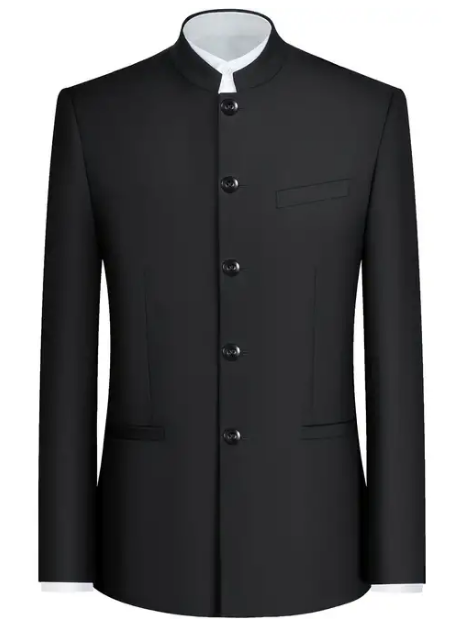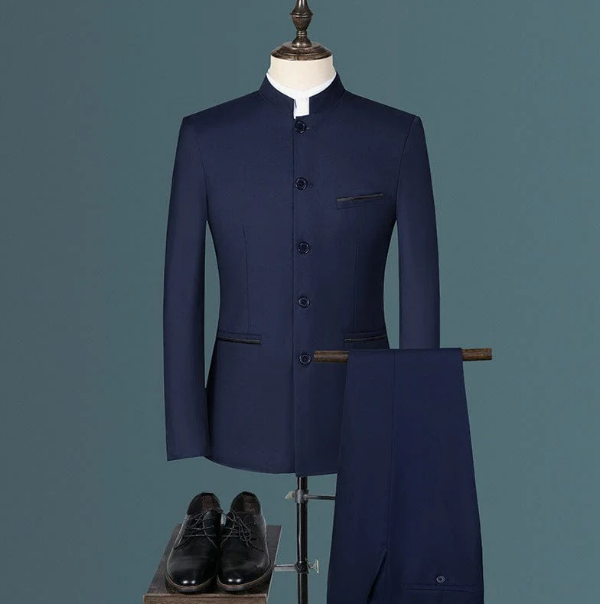Understanding the Chinese Suit
A Chinese suit, often referred to as the Tang suit or Zhongshan suit, presents a sartorial symbol deeply rooted in Chinese culture. This attire, a fusion of traditional Chinese elements and modern design, continues to influence fashion trends and formal wear in China and across the globe.
The History and Evolution
The origins of the Chinese suit trace back to the Qing Dynasty, with garments like the changpao and magua shaping early styles. Revolutionary leader Sun Yat-sen introduced the Zhongshan suit in the 20th century, which eventually became known as the “Mao suit” globally after being popularized by Mao Zedong. The traditional Tang suit, with its distinct mandarin collar and intricate button knots, draws inspiration from the Qing Dynasty’s clothing yet has evolved into a piece often worn for festive occasions.

Key Characteristics and Variations
Key features define a Chinese suit, such as the stand-up collar, four pockets, and five-center front buttons representing the core concepts of Confucianism. Material quality varies, ranging from silk to linen, to suit different climates and preferences. Color also plays a crucial role, with red symbolizing good fortune and black representing solemnity. The variations available today accommodate a wide array of tastes, from embroidered silk for weddings to simplified cotton versions for casual wear.
Modern tailoring techniques have introduced slimmer fits and shorter jacket lengths to meet contemporary style standards, ensuring that the Chinese suit remains a versatile option in men’s fashion. Whether for a traditional festival or a formal gathering, the Chinese suit stands out for its elegance and cultural significance.
Choosing the Right Chinese Suit
Selecting an appropriate Chinese suit involves understanding the event’s formality and ensuring a perfect fit, reflecting respect for the tradition and attention to personal style.
Considering Occasion and Formality
Different occasions call for different types of Chinese suits. A wedding, for example, favors a red silk suit, symbolizing luck and joy, while business events often require a subtle, dark-colored Zhongshan suit. Festivals may invite more elaborate designs, with patterns that reflect the event’s spirit. It’s crucial to match the suit’s formality with the occasion to honor the event’s essence and maintain cultural appropriateness.
Selecting the Proper Size and Fit
A well-fitting Chinese suit flatters the wearer’s figure and ensures comfort. The jacket should allow room for movement without excess fabric, and the trousers should sit at the waist comfortably without the need for a belt. Accurate measurements for chest, waist, and sleeve length are vital, and one must always check the size against the seller’s chart, as sizes can vary significantly between manufacturers. High-quality materials like fine silk or linen ensure the suit maintains its shape and structure over time, providing both durability and a polished appearance.
The Components of a Chinese Suit
A Chinese suit typically comprises two main elements: the jacket and the trousers. Each component plays a crucial role in the overall aesthetic and functionality of the attire.
The Jacket: Styles and Designs
The jacket, an emblem of the suit’s formality, varies in style and design to suit different tastes and occasions. Traditional jackets feature a mandarin collar, a style that stands up and wraps around the neck, offering a sophisticated look. Designers may infuse modern elements, such as slim-fit cuts or Western-style lapels, to update the classic silhouette for contemporary wearers. Materials range from luxurious brocade for celebratory events to more subdued wool blends for everyday professional wear. Jackets may also vary in length; some extend just below the waist, while others reach mid-thigh, offering additional coverage and a more traditional appearance.
The Trousers: Cut and Length
Trousers in a Chinese suit complement the jacket, following the principle of harmony in design. They often have a straight-leg cut, allowing ease of movement and a clean line. The length is crucial; it should brush the top of the shoe without creating a break. This precision ensures a tailored look that enhances the suit’s elegance. For formal occasions, trousers feature a higher waist and may include subtle pleating, while casual variations sit lower and sport a flatter front. Regardless of style, the quality of the material and the precision of the cut determine both the trousers’ appearance and their longevity.
Accessorizing the Chinese Suit
Accessorizing can enhance the charm of a Chinese suit, whether one chooses traditional embellishments or opts for a modern twist.
Traditional Accessories
For a classic look, accessories like the silk pocket square and cufflinks add a touch of sophistication. Men often select a pocket square in a color that complements the suit, carefully folded to just peek out of the jacket’s pocket. Cufflinks, typically made from fine metals and sometimes featuring Chinese characters or symbols, secure the shirt’s cuffs and add a subtle glint of elegance. Traditional footwear, such as cloth shoes with rubber soles, ensures both comfort and style.
Modern Twists
Introducing modern accessories to a Chinese suit can create a unique and personal look. A leather belt with a simple buckle can give the suit a contemporary edge while maintaining its traditional silhouette. Watches are a popular choice; a slim, classic watch design respects the suit’s formality without overshadowing it. For those looking to make a statement, a pair of designer sunglasses or a contrasting tie can serve as a focal point, adding personality to the ensemble. It’s important that the modern accessories don’t clash with the suit’s traditional aesthetics, but rather enhance the overall outfit.
Dressing in a Chinese Suit
Wearing a Chinese suit involves more than just putting on clothes; it’s about presenting oneself with elegance and cultural awareness.
Layering and Combining Pieces
When layering a Chinese suit, start with a fine, lightweight shirt, preferably in a complementary color. For colder weather, a thin vest can go under the jacket without adding bulk. It’s important to balance colors and textures, ensuring the layers work together harmoniously. Pair the suit with a darker jacket for formal events or a lighter one for casual affairs. The beauty of layering lies in the ability to mix and match pieces, which can transform the look for any occasion.

Ensuring Comfort and Mobility
A well-fitted Chinese suit should allow freedom of movement. The fabric should not pull across the shoulders or waist while moving. Opt for a suit made with materials that have a bit of stretch to accommodate different postures and activities throughout the day. The trousers should offer ease around the hips and knees, with a tailored but not tight fit. Comfort also extends to breathability; natural fabrics like silk and linen promote air flow, which is essential for staying comfortable, especially in warmer climates or during longer events.
Care and Maintenance of a Chinese Suit
Proper care extends the life of a Chinese suit, ensuring it remains a staple for ceremonies and significant events for years to come.
Cleaning and Storage
Always check the care label before cleaning. Many Chinese suits require dry cleaning due to delicate fabrics and construction. If a suit is silk, avoid water to prevent rings or stains. For storage, use a wide, padded hanger to maintain the shape of the shoulders and cover the suit with a cloth garment bag to protect against dust and moths. Never store a Chinese suit in plastic as it needs to breathe.
Tips for Longevity and Preservation
To preserve a Chinese suit, avoid over-wearing and alternate with other outfits. Handle the suit with clean hands to prevent body oils from affecting the fabric. If the suit becomes wrinkled, use a steamer rather than an iron to avoid damage. Regularly check for any loose threads or buttons and repair them promptly to avoid further damage. When a suit is not in seasonal rotation, consider professional preservation to maintain its quality and appearance.